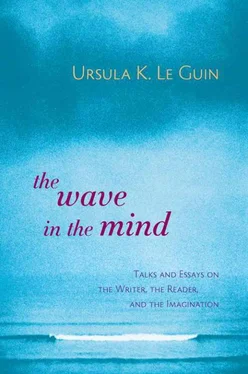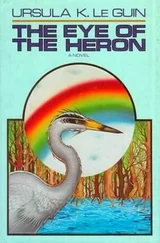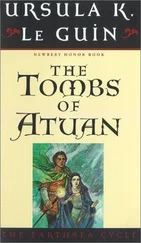Each oral performance is as unique as a snowflake, but, like a snowflake, it will very likely be repeated; and its principle internal organisational device is repetition. Rhythm is basic to oral performance, and it is chiefly obtained by recurrence, by repetition.
From now on I am going to be repeating myself about repetition. One reason there is a lot of repetition in oral performance, as in ordinary speech, is the need for redundancy. The reading eye can turn back and reread and make certain; therefore, in writing you need only say a thing once, if you say it well. So we writers are taught to be afraid of repeating ourselves, to shun even the appearance of repetition. But in speaking, words go by very quickly and are gone; they fly away, they are wingéd words. Speakers know that they may need to bring the whole flock back round again more than once. Orators, reciters, storytellers shamelessly say the same thing several times, maybe varying the words maybe not. Redundancy is not a sin in oral performance, as it has become in writing, but a virtue.
Speakers also use repetition because it is the best device they have to organise, to shape and structure, what they are saying. Experienced listeners in an oral culture—such as a three-year-old who gets read to or told stories a lot—expect repetition. They wait for it. Repetition both raises expectations and fulfills them. Minor variation is expected, but extreme variation, though it adds surprise, which may be welcomed, more likely will be rejected as frivolous or corrupt. Tell it the right way, Mama!
Repetition may be of a single word; of a phrase or sentence; of an image; of an event or action in the story; of a character’s behavior; of a structural element of the piece.
Words and phrases are the most likely to be repeated verbatim. The simplest example of this is starter words, words used to begin a sentence. In the King James Bible, it’s And. And the Lord smote the idolaters. And the idols were destroyed. And the people lamented in the streets.—In a Paiute story, a lot of sentences begin with Then— yaisi in Paiute. Then Coyote did this. Then Grey Wolf said this. Then they went in.— And and Yaisi are key sounds, cues to the listener that a new sentence, a new event, is under way; also they may provide a tiny mental resting place for the teller or reader of the story. These repeated starter words provide a beat, not a regular, metric beat, because this isn’t poetry, it’s narrative prose, but just the same a beat at intervals: a pulse that follows a pause, a sound that follows a silence.
In spoken narrative, silence plays a huge active part. Without silence, pauses, rests, there is no rhythm. Only noise. Noise is by definition meaningless, sound without significance. Significance is born of the rhythmic alternation of void and event—pause and act—silence and word. Repeated words are markers of this rhythm, drumbeats to which the story dances.
For centuries, those huge poems the Iliad and the Odyssey did not exist in writing but only in oral performance. The version we have is the one that happened to get written down. We know now that a tremendous proportion of the language of the epics consists of stock phrases, repeatable terms, used where they were needed to fill out the meter or to take up slack while the performer thought of what Achilles or Odysseus did next. No performer could possibly remember the whole thing verbatim. Every performance was half recital and half improvisation, using that vast stock of ready-made phrases. So the wine-dark sea and rosy-fingered dawn are little metrical bricks, fitted in wherever the hexameter fell short. They are also, of course, beautiful images. Does it lessen them that they are repeated where the meter needs them? Do we not in fact greet their repetition with pleasure, as we do the repetition of a musical phrase or motif in a sonata or symphony?
Repeated actions in oral narrative are essential structural elements. They are usually varied, partial repetitions, building up expectation towards fulfillment. The first son of the king goes out and behaves badly to a wolf and the dragon eats him. The second son of the king goes out and behaves badly to a deer and the dragon eats him. The third son of the king goes out and rescues the wolf from a trap, frees the deer from a snare, and the wolf and the deer tell him how to kill the dragon and find the princess, and he does, and they get married and live happily ever after.
As for repeated behavior of characters, contemporary novelists are likely to consider predictability to be a fault, a flaw, in their invention. Repeated or predictable behavior, however, is what constitutes a character—in life or novels. If it’s highly, obviously predictable, the character is a stereotype or caricature; but the gradations are endless. Some people find all Dickens’s characters mere stereotypes. I don’t. When Mr. Micawber says “Something is certain to turn up,” the first time, it’s insignificant; the second time, it’s revealing; by the third or fourth time he’s said it in the teeth of total financial disaster, it’s significant and funny; and by the end of the book, when all his hopes have been savagely defeated, “Something is certain to turn up” is both funny and profoundly sad.
I use an example from literature, not from oral texts, because Dickens’s relationship to orality and oral performance is very close, maybe closer than any other novelist since 1800 except, possibly, Tolkien. The repetitive behavior of Dickens’s characters is more characteristic of oral narrative than of the novel in general. Delicate probings into the convolutions of the private psyche in a unique situation aren’t well suited to tales told aloud. Characters of oral narratives may be vivid, powerful, worthy of a great deal of thinking about: Achilles, Hector, Odysseus, Roland and Oliver, Cinderella, the Queen and Snow White, Raven, Br’er Rabbit, Coyote. They are not one-dimensional; their motivations may be profoundly complex; the moral situations they are in are of wide and deep human relevance. But as a rule, they can be summed up in a few words, as characters in novels cannot. Their name may even be exemplary of a certain kind of behavior. And they can be summoned into the hearer’s imagination by the mere mention of characteristic behavior: Then said wily Odysseus, thinking how to save himself… Coyote was going along and he saw some girls by the river…. We’ve heard about Odysseus being wily. We’ve heard about Coyote seeing some girls. We know, in general, what to expect. Odysseus will get away with it, but at a cost; he will be damaged. Coyote won’t get away with it, will be made a complete fool of, and will trot away perfectly unashamed. The storyteller says the name Odysseus, or the name Coyote, and we the listeners await the fulfillment of our expectations, and that waiting is one of the great pleasures life offers us.
Genre literature offers us that pleasure. That is perhaps the central reason for the obstinate popularity of the romance, the mystery, science fiction, and the western, despite decades of critical and academic ignorance and contempt. A genre novel fulfills certain generic obligations. A mystery provides some kind of puzzle and its resolution; a fantasy breaks the rules of reality in a significant way; a romance offers the frustration and fulfillment of a love story. On the lowest plane, genre offers the kind of reliability hamburger chains offer: If you pick up a Louis L’Amour western or the eighteenth mystery in a series, you know what you’re going to get. But if you pick up Molly Gloss’s The Jump-Off Creek , a western, or Tolkien’s The Lord of the Rings , a fantasy, or Philip K. Dick’s The Man in the High Castle , a science fiction novel, although each reliably fulfills the obligations of its genre, it is also utterly unpredictable, a novel, a work of art.
Читать дальше




